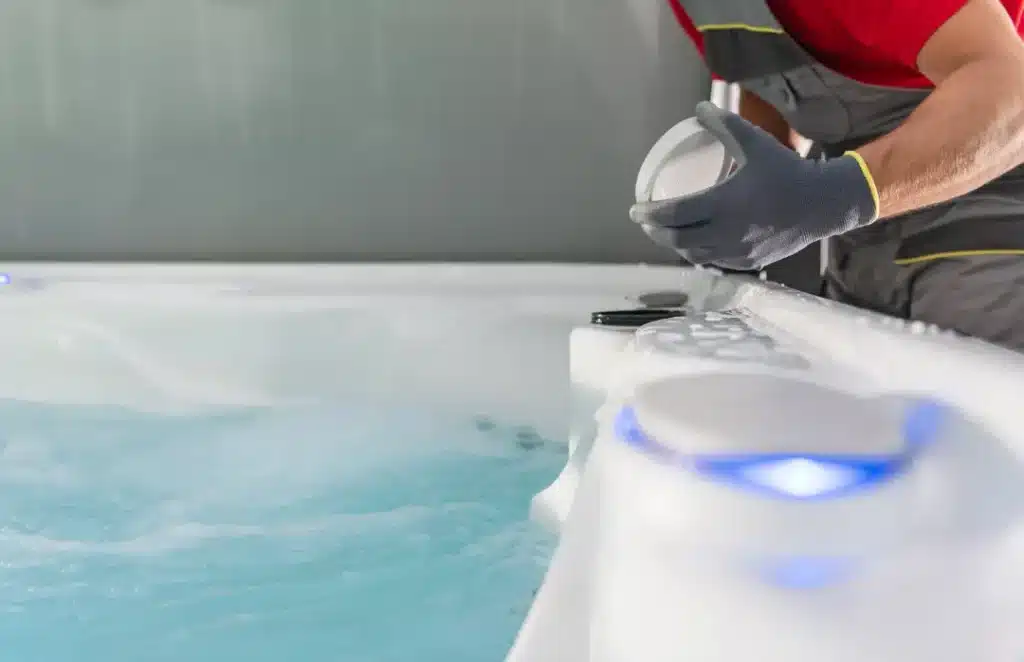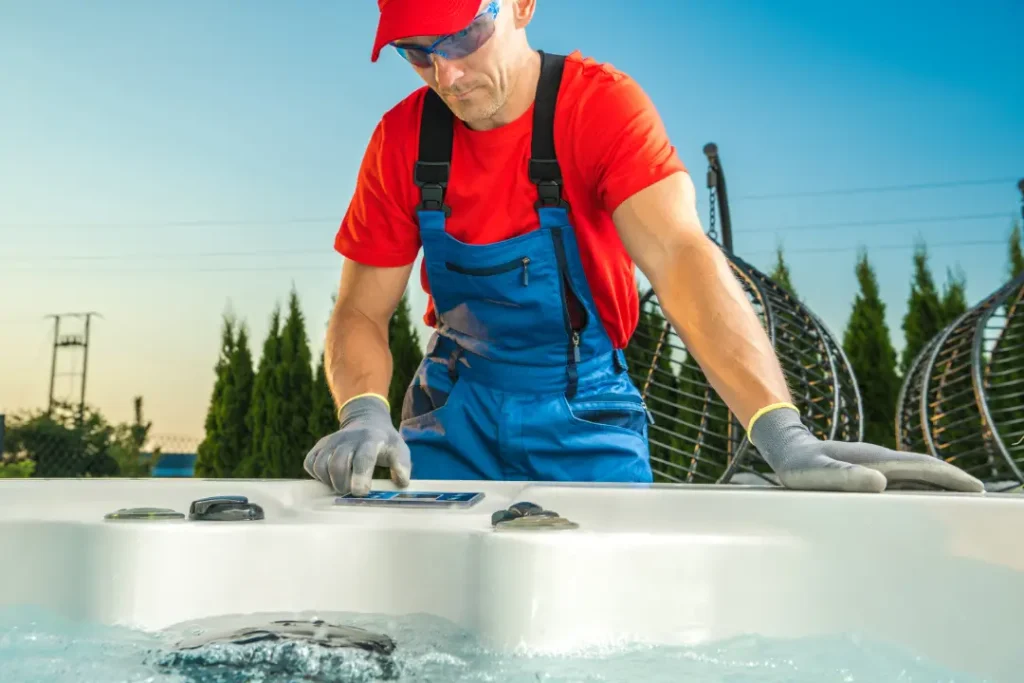Phosphates in your hot tub can cause cloudy water and algae growth. They come from tap water, rain, and debris.
Learn about the causes of hot tub phosphates and how to remove them to keep your water clear and clean.
Key Takeaways
- Phosphates, found in various water sources and products, can elevate levels in hot tubs, necessitating management to maintain water clarity.
- High phosphate levels promote algae growth and reduce sanitizer effectiveness, leading to poor water quality and increased maintenance costs.
- Regular testing, phosphate removers, and natural enzymes are essential for keeping hot tub phosphate levels low and ensuring clean water.
How Do Phosphates Enter Hot Tub Water?
Phosphates are compounds that occur naturally in various water sources, including groundwater, rivers, and rainwater. These compounds consist of the element phosphorus combined with oxygen and may also contain hydrogen and calcium, among other elements. Interestingly, phosphates are not only found in food and water but are also an integral part of our bodies.
Several factors can introduce phosphates into the water systems of hot tubs. These include animal waste, natural debris from the surrounding environment, and precipitation. Understanding how phosphates enter your hot tub is crucial for maintaining clear and inviting water. To achieve optimal water quality in your hot tub, keeping phosphate levels below 300 parts per billion is important.
By having a clear understanding of what phosphates are and where they come from, you can effectively manage their presence in your hot tub’s ecosystem, allowing you to continue enjoying clean and welcoming waters.

Common Causes of High Phosphate Levels in Hot Tubs
Generally, phosphates in hot tubs often originate from tap water, rainwater, and organic debris. So when you first fill your hot tub with source water, you’re likely to introduce some phosphates into the system.
Hot tub water can also accumulate phosphates from personal care items like lotions, shampoos, and toothpaste. Environmental debris, including dust, soil particles, leaves, and decomposing natural materials, also adds to the phosphate content. Frequent use of household cleaners may boost phosphate levels in hot tub water.
Additionally, bird droppings on surfaces near your hot tub, decaying insects, and residue soap left on swimwear could raise these phosphate levels even more.
What Are the Effects of High Phosphate Levels on Hot Tub Water Quality?
Elevated phosphate levels within hot tub water can lead to several undesirable outcomes, including the encouragement of algae growth. As a food source for algae, phosphates can spur on algae blooms that may discolor your hot tub water with a green tint and leave it covered in a slimy film. This detracts from its aesthetic appeal and makes for an unsatisfactory experience for those using the tub.
The increase in algae requires a higher use of sanitizing agents, like chlorine, to keep the water safe and hygienic. High concentrations of phosphates can reduce the effectiveness of these sanitizers, making it more difficult to maintain clean and healthy hot tub waters. As a result, this situation can lead to higher maintenance costs and a greater need for chemical treatments.
Visible signs of excess phosphates include a murky appearance, unpleasant odors, and a slippery surface in your hot tub. While phosphates themselves are unlikely to harm bathers, they create conditions that most people would find unappealing. Additionally, excessive phosphates can lead to scaling on various spa surfaces, increasing maintenance challenges and complicating operations.
Impact on Salt Water Hot Tubs
Elevated levels of phosphates in saltwater hot tubs pose a significant challenge. Since these systems depend on converting salt into chlorine, the presence of high phosphate concentrations can impair their ability to generate sufficient sanitizing agents. Consequently, this complicates the upkeep of optimal water quality and may result in recurrent maintenance difficulties.
Saltwater hot tubs need to maintain a precise equilibrium for proper functionality, but excessive phosphate levels can upset this balance and compromise the effectiveness of the salt system. It is vital to ensure that phosphate levels remain low within such setups to guarantee efficient operation and extend their lifespan.

How to Test for Phosphates in Your Hot Tub
Examining the hot tub water for phosphate levels is simple yet crucial to preserving high-quality water conditions. To achieve precise and user-friendly testing, high-quality phosphate test strips are advised.
To test for phosphates, adhere to the guidelines that accompany your chosen test kit or strips. This usually requires immersing a strip into the tub water and pausing briefly to interpret the outcome. By regularly conducting this test, you can swiftly identify any elevated phosphate levels in your hot tub and address them before they escalate into more serious complications.
Consistent monitoring of phosphate levels plays a vital role in keeping the hot tub water pristine and enjoyable for each owner, thereby improving their overall experience with their tub.
Effective Methods to Remove Phosphates from Hot Tubs
There are multiple reliable ways to eliminate phosphates from hot tub water. One common method is the use of phosphate removers that capture and remove phosphates through the filtration process. Alternatively, products containing natural enzymes can be employed to decompose organic substances that lead to an accumulation of phosphates.

Using Phosphate Removers
Phosphate removers serve as an efficient method for decreasing the concentration of phosphates in spa water. Special formulations of phosphate removers are crafted to target and substantially diminish the levels of phosphate within your hot tub’s water system. When elevated phosphate readings persist despite routine upkeep, resorting to a phosphate remover proves judicious.
Adjusting filter cycles and conducting more frequent filter rinses can enhance the effectiveness of these removers. This process works by converting phosphates into a form readily removed from the water through filtration.
By integrating a phosphate remover into your maintenance regimen, you ensure that once your hot tub’s water achieves balance, it sustains minimal levels of phosphates going forward.
Utilizing Natural Enzymes
Employing natural enzymes presents an environmentally conscious method for regulating phosphate levels in hot tubs. By decomposing organic materials, which escalates the accumulation of phosphates, these natural enzyme solutions effectively lower phosphate counts and enhance water quality.
To guarantee that natural enzymes operate at their peak efficiency, it’s crucial to first adjust and stabilize pH and alkalinity levels in your hot tub water. Incorporating these enzymes into your regular maintenance schedule can help maintain clear and pristine water in your tub with a reduced reliance on chemicals.
Preventive Measures to Maintain Low Phosphate Levels
Preventing high phosphate levels in your hot tub involves:
- Regular testing of the water is necessary to detect phosphate levels early.
- Taking corrective action before problems arise.
- Maintaining balanced pH and alkalinity levels for effective phosphate management.
Rinsing swimsuits after washing reduces the transfer of phosphates from soap residues into the hot tub. Additionally, using phosphate removers as part of your routine maintenance can help keep phosphate levels in check.
Regular maintenance and preventive measures are essential to keeping phosphate levels low and ensuring pristine hot tub water.
How Action Spa Repair Can Help Your Hot Tub Needs
At Action Spa Repair, we don’t just fix hot tubs but restore them to flawless functionality with precision, expertise, and a commitment to quality that sets us apart. With over 30 years of hot tub repair experience servicing San Diego and surrounding areas, our team has encountered and solved virtually every hot tub issue imaginable.
Whether you’re dealing with phosphate buildup, heater malfunctions, leaks, or jet failures, we have the skills and parts available to get your spa running smoothly again. Our fast response times, highly trained technicians, and fully stocked service vehicles mean less downtime and more time enjoying your hot tub. Plus, we repair all brands and models, so no matter what type of spa you own, you can count on us.
Enjoy lasting results and complete peace of mind with our service warranties. Our expertise allows us to diagnose and fix problems quickly, and our dedication to customer satisfaction ensures that we get the job done right the first time. If you are facing any hot tub issues, don’t waste time with trial and error. Call Action Spa Repair today at 619-444-1720 and let the experts handle it.
Frequently Asked Questions
What is the easiest way to remove phosphates?
The easiest way to remove phosphates is to use a phosphate remover product, which effectively breaks down and dissolves phosphates in pool water.
Additionally, vacuuming the substrate can help prevent the accumulation of phosphorus from settled organic matter.
What are phosphates, and why are they a problem for hot tubs?
Phosphates, made up of phosphorus and oxygen, promote algae growth in hot tubs, resulting in poor water quality and higher maintenance costs.
It’s essential to manage phosphates to maintain a clean and safe hot tub environment.
How do phosphates get into my hot tub?
Phosphates can enter your hot tub primarily from tap water, rainwater, personal care products, and environmental debris such as dirt and leaves.
It’s important to regularly monitor and manage phosphate levels to maintain water quality.
What are effective methods to remove phosphates from hot tubs?
To effectively remove phosphates from hot tubs, consider using phosphate removers and natural enzyme products.
These methods help manage and reduce phosphate levels efficiently.
Conclusion
It’s crucial to keep phosphate levels low in order to maintain clear and appealing hot tub water. To manage these phosphates effectively, it’s important to know what they are and the ways they can make their way into your spa. A rigorous maintenance program that includes consistent testing for phosphate, utilizing removers along with natural enzymes, and taking preventative actions is key.
Seeking assistance from our expert team at Action Spa Repair can greatly benefit you in keeping your hot tub at its best. By applying the advice and methods outlined in this guide, a pristine spa experience throughout all seasons is within reach.
